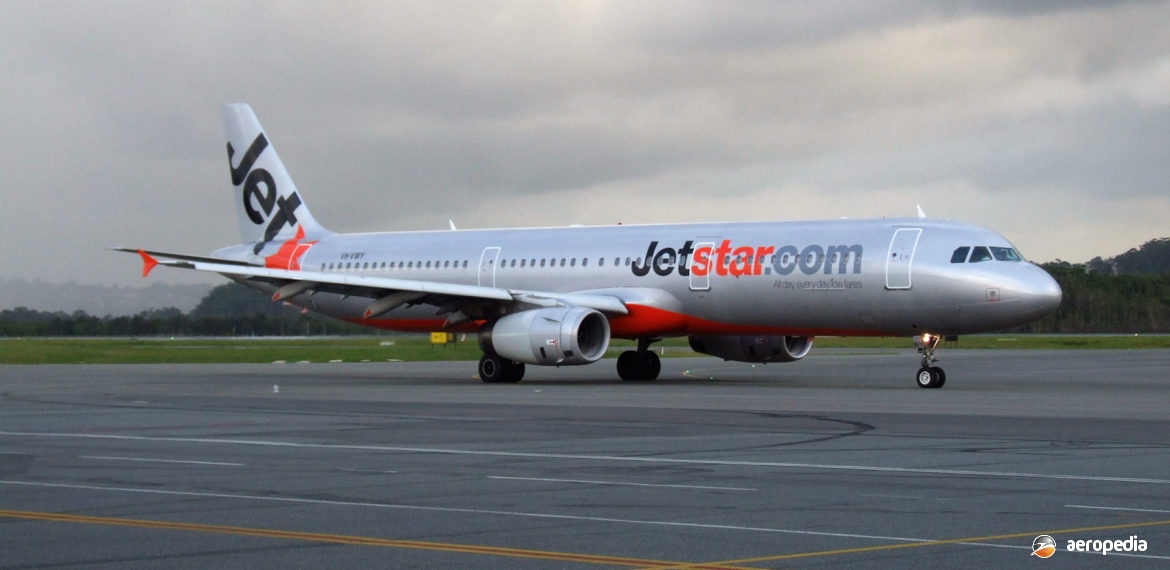Photograph:
Airbus A321-231 VH-VWY (c/n 1408) at Coolangatta, QLD (David C Eyre)
Country of origin:
France
Description:
Commercial airliner
Power Plant:
Two 30,000 lbst CFM International CFM56-5 turbofans; or
Two 30,000 lbst International Aero engines V2530-A5 turbofans
Specifications:
- Wingspan: 34.10 m (111 ft 9 in)
- Length: 44.51 m (146 ft)
- Height: 11.81 m (38 ft 9 in)
- Wing area: 123 m² (1,320 sq ft)
- Max cruising speed: 903 km/h (561 mph)
- Economical cruising speed: 828 km/h (515 mph)
- Range: (A321-100) with 186 passengers and reserves 4,260 km (2,647 miles)
- Range: (A321-200) 4,907 km (3,049 miles)
- Empty weight: 47,500 kg (104,718 lb)
- Loaded weight: 83,000 kg (182,981 lb)
History:
The A321 was designed by Airbus to basically compete against the Boeing 757, which at that time had been in service for some years. Being a 180 seater, it was a direct derivative of the A320, the A321 retaining the basic features of the earlier model, including fly-by-wire flight controls, sidestick controllers, all-composite fin and tailplane,and six-abreast seating with a single aisle, but had extensions to the fuselage to increase seating capacity by 24 per cent and underfloor hold volume by 40 per cent. There was some strengthening of the wing and centre-section, a change to double-slotted flaps and a simplified fuel system.
The fuselage was increased in length by 6.93 m (23 ft 9 in) and this amounted to 13 fuselage frames. The fuselage stretch comprised a plug of 4.27 m (14 ft) ahead of the wing and a plug of 2.67 m (8 ft 9 in) behind the wing. The forward fuselage plug was built by Alenia in Italy, British Aerospace building the wings at Chester and the rear plug at Filton in the United Kingdom. The fuselage assembly took place at the DASA facility at Hamburg in Germany.
One of the early orders for the A321 was for ten aircraft for Ansett Airways, with deliveries to commence in July 1995, but, following the demise of that airline, none were delivered.
In late 2007 Qantas announced it had ordered 68 Airbus A320s and A321s for its subsidiary, Jetstar, with options on a further 40, the first of 17 A321s to be delivered in early 2008. The first Jetstar A321 became VH-VWZ (c/n 1195 – ex N583NK, D-ALAL), an A321-231, which had been built for German airline Aero Lloyd and delivered in 2000. It later operated with Ryan International Airlines of Wichita, Kansas, USA on lease until imported to Australia. Further A321-231s were subsequently delivered, including VH-VWY (c/n 1408 – ex N584NK), VH-VWX (c/n 3899 – ex D-AVZW) and VH-VWQ (c/n 7384 – ex D-AZAI).
The A321 prototype first flew on 11 March 1993 at Hamburg, flying on this occasion for a period of four hours and 40 mins. A typical two-class layout was for 186 passengers, with up to 220 in a high-density layout. Four aircraft were used in the certification and testing process, two with IAE engines and two with CFM engines. First aircraft delivery was to Lufthansa in early 1994.
Development of the series has continued, the first A321-200 flying in December 1996, the first production aircraft of this model being delivered to ILFC for lease to an airline. The A321-200 was developed from the A321-100 and represented a response to market demand for a longer-range version for short and medium haul flights.
In June 2014 Air New Zealand announced it would upgrade its Airbus A320 fleet from 2017 onwards with A320-neo aircraft, obtaining a total of 13 aircraft, three of which would be A321s. In late 2018 Air New Zealand commenced taking delivery of its A321-171NXs, the first becoming ZK-NNA (c/n 8496), followed by ZK-NNB (c/n 8542).
In 2016 Jetstar announced it was increasing its fleet of A321s to six aircraft. At that time the Jetstar Airways fleet comprised six A321-231s VH-VWT (c/n 3717 – ex [VT-KRE], D-AVZO), VH-VWU (c/n 3948 – ex D-AZAL), VH-VWW² (c/n 3916 – ex D-AVZX), VH-VWX (c/n 3899 – ex D-AVZW), VH-VWY (c/n 1408 – ex N584NK) and VH-VWZ (c/n 1195 – ex N583NK, D-ALAL). Jetstar Pacific operated a further two A321s.

